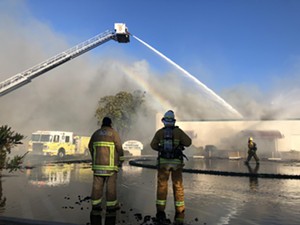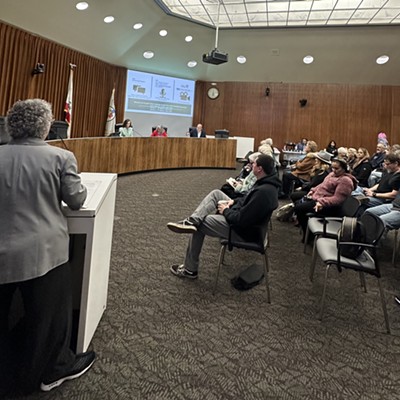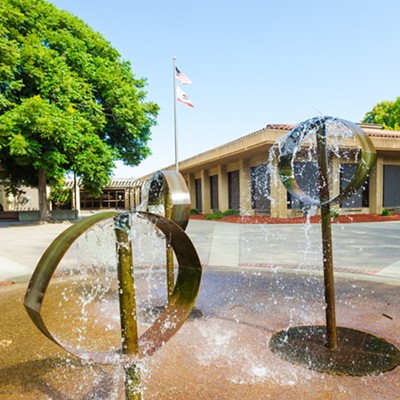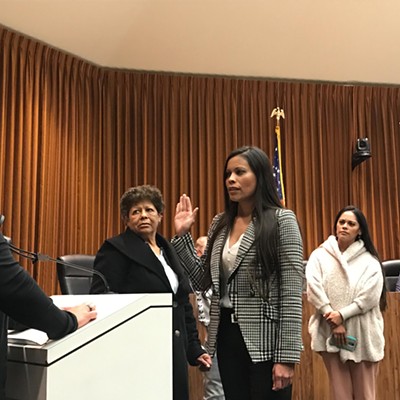Santa Maria Fire Battalion Chief Evan Scott got his third physical exam in his 20-year career as a Santa Maria firefighter after he helped establish the department’s health and wellness program.

“It was a big deal. It was the goal I was shooting for before I retired,” Scott told the Sun. “I banged that drum for 20 years, and I’m happy we finally got it.”
The Santa Maria Fire Department was the only fire department in Santa Barbara County that didn’t receive annual physicals that were to “industry standard,” set by the National Fire Protection Association (NFPA)—a U.S.-based international nonprofit dedicated to eliminating death, injury, property and economic loss to fire.
“That standard is different from a personal doctor because it measures specific benchmarks that are firefighter-related and geared toward measuring … a lot of standards to the effect of screening for cancers and things that are more prevalent in the firefighter community, versus outside communities,” he said. “Because they are done every year, we are able to catch medical concerns before they get to something that runs out of control.”
The Santa Maria Fire Department’s first iteration of the wellness program began nearly 25 years ago after the fire chief at the time applied for a one-time grant that helped get weight equipment for a weight room, provided a few personal training classes, and offered physicals, Scott said.
“Once the money went, it was gone and it was done,” he said. “As the years went by, it started to grow and became more popular to facilitate. I never received an actual budget to this day for the program, but over the last 20 years I’ve gotten more support from the fire administration.”
The Santa Maria Fire Department established a six-person Wellness Committee to oversee the program’s growth and improvement, he said. In 2021, Scott applied for a one-time $70,000 Federal Emergency Management Agency grant to allow the department to provide NFPA-standard physicals to every firefighter, which include annual cancer screenings, cardiovascular analysis, blood tests, and hearing and vision tests for every firefighter.
“Our Wellness Committee received a lot of appreciation for the physicals because everybody wanted them, and they were long overdue,” Scott said.
Now that the federal grant expired, the Santa Maria Fire Department will approach the city during budget hearings this summer to request funding from the department’s annual budget to cover continued physical exams. Statewide, local fire agencies are taking similar measures to provide annual physicals for firefighters that meet national standards.
“Not supporting annual physicals in 2024, in my own mind, it’s not OK; it needs to be done. I have yet to find somebody to convince me that it’s not worth it,” Scott said.
The grant-funded physicals saw 100 percent participation from the department and helped identify early-stage cancer in one of the firefighters on staff, Santa Maria Fire Chief Brad Dandridge told the Sun.
“The fact that we caught it was extremely helpful because this cancer would have been detrimental to his health,” Dandridge said, adding that the screenings save money for the city.
California state law presumes that firefighters get cancer from their jobs and requires local jurisdictions to cover full hospital, surgical, and medical treatment.
“Cancer is a leading cause of death in firefighters. We have a greater risk of certain types of cancers—our exposure to smoke and hazardous chemicals, all these increase our risk of cancer,” Dandridge said. “If implemented correctly, [physicals] should realize significant cost in workers’ compensation savings and medical issues, which is a win-win [for] all parties involved.”
Dandridge will approach the City Council before July to request approximately $60,000 a year to be allocated in the next budget cycle (2025 to 2027) to continue funding the program.
“I think it’s a benefit not only to the firefighters but to the city and community as well. If we provide these programs in the workforce, we will have [healthier], more fit, capable firefighters,” he said. “We put ourselves knowingly in harm’s way, that is what we like to do to protect our residents in our community. It’s only right to continue to support these programs to keep a healthy workforce.”
The fire chief came to Santa Maria last year after working at the Fresno Fire Department, where he helped establish a similar physicals program for a department that has 21 stations and 350 firefighters.
Similar to Santa Maria, Fresno’s health and wellness program began through a general fitness program 15 to 20 years ago, Fresno Fire Captain and Training Officer Shane Brown told the Sun.
The physicals program developed five years ago once the city got a new mayor who supported the program and worked with Dandridge and the department to provide annual exams to NFPA standards and an MRI body scan every two years, Brown said.
“A dozen or so cancers have been detected early and treated with long-term effects. Because these physicals are so detailed they can catch things early, they were able to handle it and get treated,” Brown said. “This elongates their career and minimizes impact to the city.”
Brown said the physicals helped him find skin cancer last year and a nodule on his thyroid. While the practitioner said the nodule was benign, he was still sent to a specialist to confirm.
“I feel healthy, but if I were to ignore it and found out I had thyroid cancer, it would be a lot harder to overcome,” he said.
The Ventura Fire Department conducted its first sets of annual physicals last year, Ventura EMS Administrator Heather Ellis told the Sun.
“We wrote our standard to be in compliance with the NFPA, … which was a significant change for physicals in our department,” Ellis said. “I’ve been here for eight years, and we have been doing physicals much longer than I’ve been here, but it’s been [on] an odd schedule when people were at certain ages—it was every year and others every three years and then others on a two-year scale.”
Ventura allocated $150,000 to fund physicals last year, a 50 percent increase over the previous budget cycle, she said.
“It is at a cost, but it’s a needed cost,” Ellis said. “Having been a firefighter for more than 20 years myself, I know how hard this job is on the body. I came from another state as a firefighter, and I was shocked at the physicals process.”
Before moving to California, Ellis worked as a firefighter in Indiana, where firefighters have received annual exams for decades, she said. The Indianapolis Fire Department began its program in 1979 that provides physicals, access to a public health specialist, coordinated care services, and cancer prevention education, according to the Indianapolis Fire Department website.
“That was the norm, and that’s been the norm for me since the ’90s; it didn’t matter where I worked in Indiana. … The process here for physicals was somewhat foreign and unexpected,” Ellis said. “I am thrilled to be able to offer physicals on an annual basis and for them to be facilitated on duty. That is a huge benefit to our firefighters.”
Reach Staff Writer Taylor O’Connor at [email protected].










